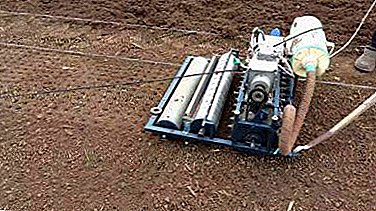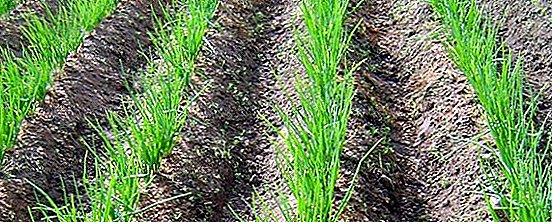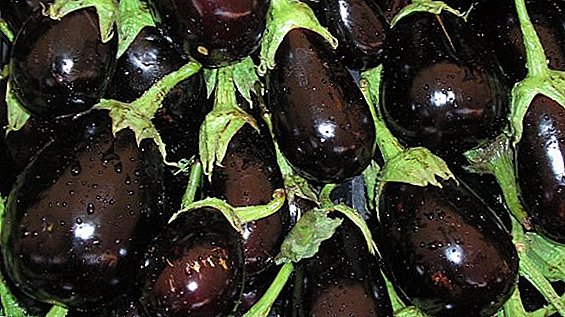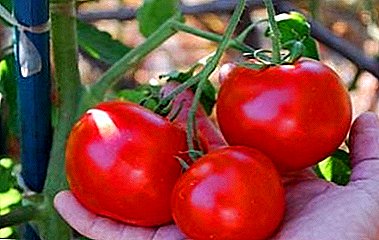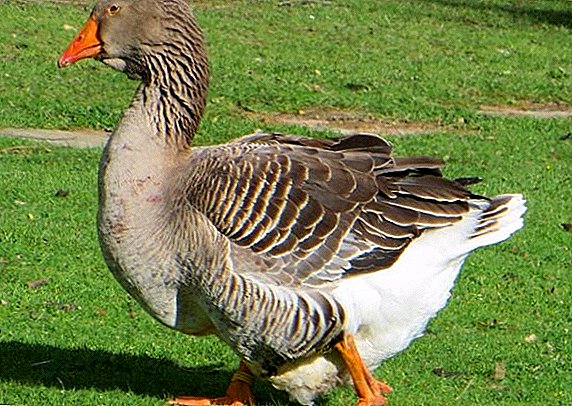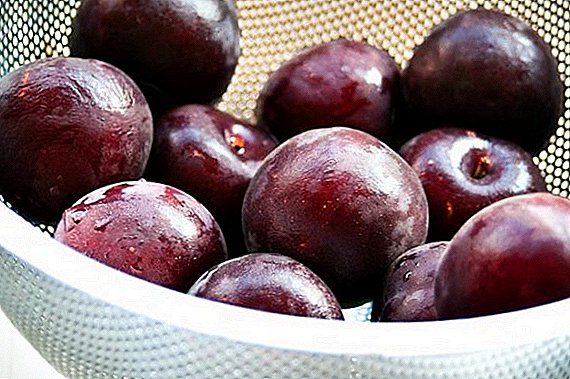 Both beginners and more experienced gardeners have a natural desire to grow something extraordinary in their garden.
Both beginners and more experienced gardeners have a natural desire to grow something extraordinary in their garden.
This can be considered a black apricot, which got its name due to the unusual color of the fruit.
Apricot variety "Kuban black": description
Before deciding to grow a variety of black apricot Kuban black, you should study its description in order to understand what conditions will need to be arranged for this crop, how to properly care for it and what to fertilize.
 Black apricots as a separate crop have not yet been recognized. They appeared completely spontaneously as a result of random pollination of apricot cherry plum. And only after that someone, having estimated the taste of the fruit, decided to plant the seed of such a fruit tree. To date, breeders have taken up this issue and produce all new varieties that have several advantages.
Black apricots as a separate crop have not yet been recognized. They appeared completely spontaneously as a result of random pollination of apricot cherry plum. And only after that someone, having estimated the taste of the fruit, decided to plant the seed of such a fruit tree. To date, breeders have taken up this issue and produce all new varieties that have several advantages.
Did you know? Black apricot is an exclusively cultivated fruit species, it does not grow in the wild.
Apricot "Kuban black" - a low tree with a thick crown. Leaves sprout on a short scape, have an oval shape, small. The fruits, on the contrary, are rather large, of the order of 35-40 g, oval in shape, dark red in color, pubescent.
The stone is separated relatively easily. With regard to taste, then, having tried such an apricot, plum will be remembered first of all, but the smell and appearance will not allow us to forget that apricot is still in the hands. The first fruits can be collected from the tree already in the third year after planting. This hybrid of apricot and plum is resistant to diseases, tolerates cold winter conditions, transportation. You can and canned and consumed fresh.
Conditions for growing a hybrid
 Apricot "Kuban black" undoubtedly attracts attention, so it is not surprising that many will be interested in how to grow this unusual garden culture. If you take a responsible approach to the choice of location, soil, and choose the right care, this culture will thank the gardener for an excellent harvest.
Apricot "Kuban black" undoubtedly attracts attention, so it is not surprising that many will be interested in how to grow this unusual garden culture. If you take a responsible approach to the choice of location, soil, and choose the right care, this culture will thank the gardener for an excellent harvest.
How to choose a place to plant apricot
Choosing "Kuban black" for growing, plant it better on the south side of the garden, as the variety loves the sun. But the absence of burns is necessary to worry. If we process the whitewash trunks in early spring, where to add the copper sulfate, then there will be no such problem. It is also advisable to consider protection from the cold wind. The tree does not tolerate excessive humidity, which means that if there is a high location of groundwater, it is better to plant it on a hill or to provide high-quality drainage.
Each seedling of apricot "Kuban black" need about 4-5 square meters. Bearing in mind that the pollination of this hybrid is cross, we organize the neighborhood with plums, cherry plum, apricots and other stone fruit trees, which can become pollinators for black apricot.
Type of soil for growing
As for the soil, even though black apricot is not too demanding of it, heavy clay still need to be avoided. The soil must be non-uniform and loose so that the roots have access to oxygen and water.
Features landing "Kuban black"
 To plant seedlings of apricot "Kuban black" can be already in late April. The ideal time, since the snow is already gone, but the earth is still not very hot. It is also possible in the fall - the beginning of October is best.
To plant seedlings of apricot "Kuban black" can be already in late April. The ideal time, since the snow is already gone, but the earth is still not very hot. It is also possible in the fall - the beginning of October is best.
Before you start planting seedlings, it is necessary to prepare the substrate. The mixture for planting is prepared from river sand, clay and peat (1: 1: 1). It is better not to abuse fertilizers during planting, because trees can start to grow rapidly and will be excessively high.
Planting process:
- First you need to dig a hole about 80-90 cm wide and 70-80 cm deep.
- Then we pour the previously prepared substrate into the pit, filling it approximately 20 cm.
- When placing a sapling in a pit, it is important to keep track of the root system, it should be freely distributed in space, in no case bend upwards and not wring. The root neck is left 3-4 cm above the ground.
- Ensuring that the sapling was standing exactly, gently sprinkle the stem with earth. The barrel can be slightly shaken, so that the roots were shrouded in soil from all sides.
- With our hands we slightly compact the earth around the root collar, forming a mound at the trunk and a hole around, it will be needed for the subsequent watering.
- Then the tree is watered, you will need 2-3 buckets of water. But you need to pour at a distance of 20-25 cm from the trunk, and not directly at him. After watering, the land usually settles, as it fills the remaining voids near the roots, so you need to add more land to the hole.
- At the end of the landing procedure it is necessary to fill the ground around the trunk with compost, peat, needles or dry leaves.
Important! In no case can not cover the trunk of the tree with any materials that can impede the air, because black apricot can suffer from vyhryvaniya and sunburn. For the winter, the trunk of this fruit tree can be tied with mattings, hessian or other materials that heat, but are well breathable.
How to care for black apricot
 Black apricot is a picky, easy-to-grow fruit tree that does not require regular dressings and special care, which will appeal not only to experienced gardeners, but also to those who are just trying themselves in this business.
Black apricot is a picky, easy-to-grow fruit tree that does not require regular dressings and special care, which will appeal not only to experienced gardeners, but also to those who are just trying themselves in this business.
Watering
The variety of black apricot "Kuban black", like many fruit trees, requires regular, but not abundant watering, especially during the period of active growth of shoots. Ideal - 1 bucket of water in 2 weeks. But starting from the end of July, watering should be stopped, because the branches will not have time to mature to the winter cold. Watering is carried out exclusively in the morning or in the evening. At the height of summer, you can additionally spray the foliage from the spray gun.
Important! Acceleration of leaves will help prepare the tree for winter. To do this, gardeners recommend in the fall to pollinate the green leaves of black apricot with dry wood ash.
Fertilizer
Fertilizing apricot "Kuban black" need twice a year: in spring and autumn. In the spring, fertilizing is carried out with ammonium nitrate, per 1 sq. M. m. takes about 12-15 g. In autumn it is fertilized with potassium chloride (13-15 g per 1 sq. m.) and superphosphate (11-12 g per 1 sq. m.)
Pruning
Pruning apricot varieties "Kuban black" - a mandatory measure for the care of this tree. The technology is a lot like apple pruning. The crown is formed in the shape of a "vase". Pruning helps to create good lighting, increase the yield of apricot. And since the tree itself is not high, it is fairly easy to make the croning. 
Positive qualities of the Kuban Black variety
Advantages of apricot "Kuban black", which distinguish this variety from some other fruit trees:
- This hybrid of apricot and plum differs late flowering. The trait is very positive, because it helps to protect the flowers from freezing. After all, quite often the winter cold can occur even when it is spring on the calendar, especially at night.
- The variety is quite resistant to various kinds of diseases.
- Black apricot "Kuban black" is not capricious, does not create difficulties in planting and in care, almost every year bears fruit.
- Apricot steadfastly endures winter and spring frosts due to a rather long rest period.
- If you properly water this black apricot, the growth rate will be low, and the tree itself will be compact. This will facilitate care, pruning and harvesting.
- It tolerates drought.
Did you know? Due to the high content of phosphorus and magnesium, the fruits of the Kuban black apricot can improve memory and increase mental performance.
 As for fruits, these fruits have not only excellent taste, but also useful properties for the human body. They have a good effect on digestion, they can work as a mild laxative and even a thirst quenching agent. Eating black apricots is recommended for metabolic disorders. Still fresh fruits will serve as a source of beta-carotene - an antioxidant, which, according to many studies, can prevent the occurrence of heart disease and even the development of cancer.
As for fruits, these fruits have not only excellent taste, but also useful properties for the human body. They have a good effect on digestion, they can work as a mild laxative and even a thirst quenching agent. Eating black apricots is recommended for metabolic disorders. Still fresh fruits will serve as a source of beta-carotene - an antioxidant, which, according to many studies, can prevent the occurrence of heart disease and even the development of cancer.To plant such an original inhabitant as black apricot into your garden is the dream of many gardeners. Indeed, it makes sense to try to grow this unusual fruit tree. After all, with proper care, a rich harvest of delicious juicy apricots of interesting color will not take long.


